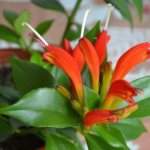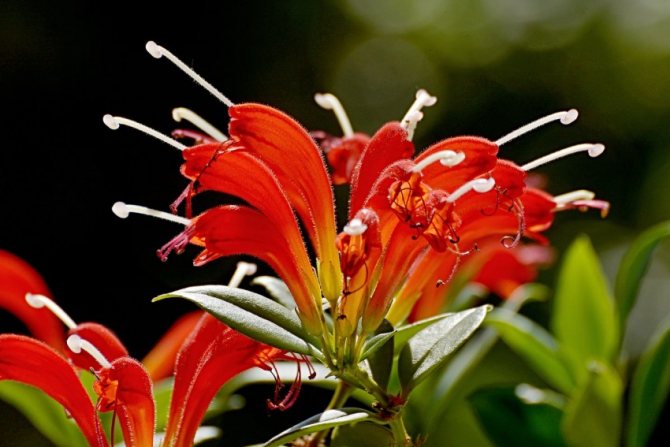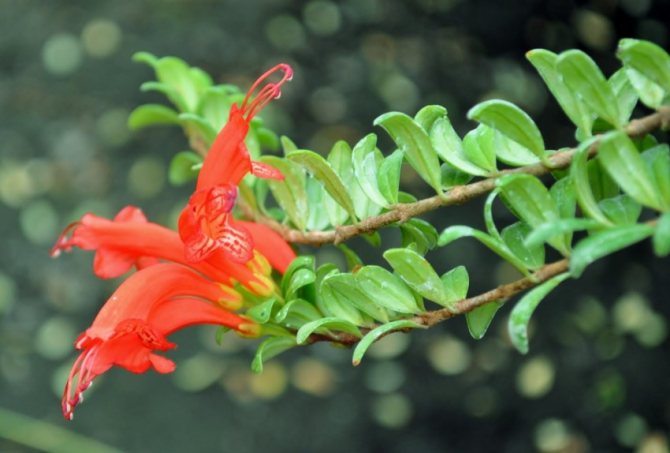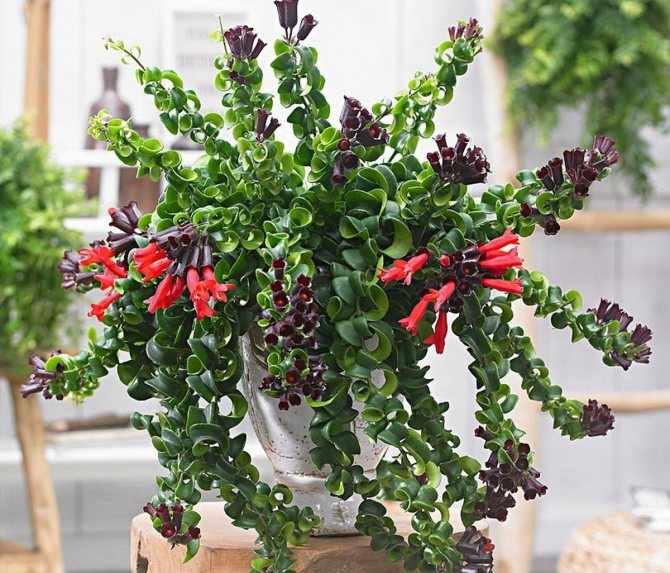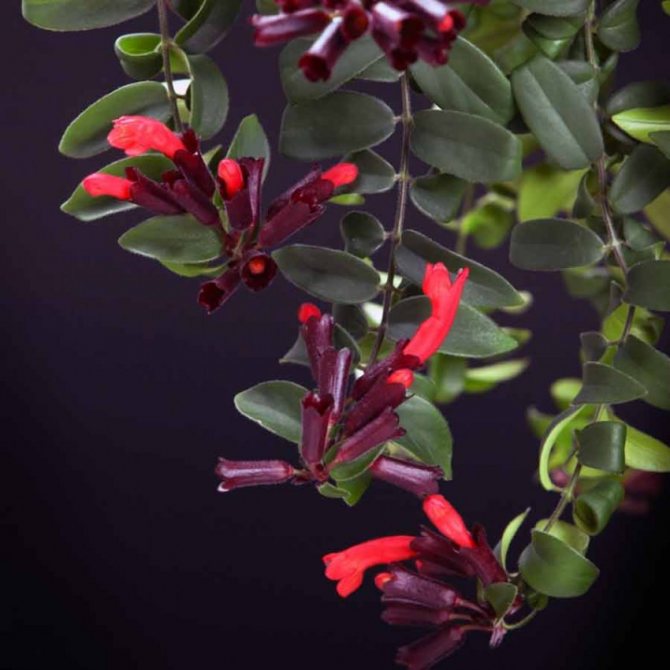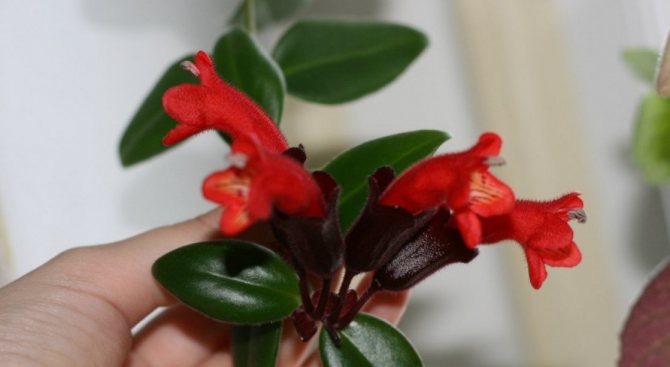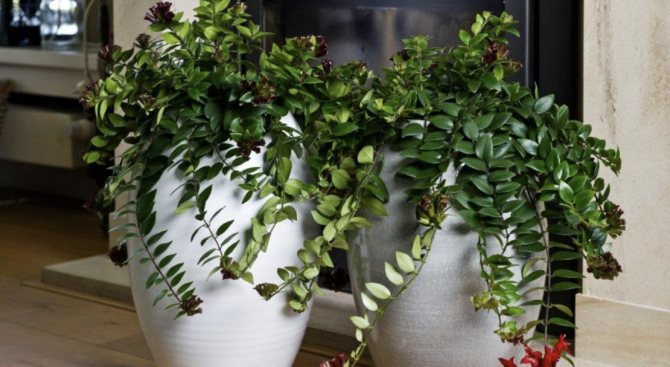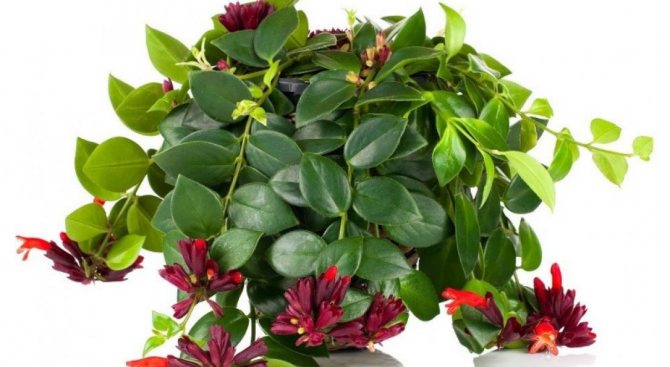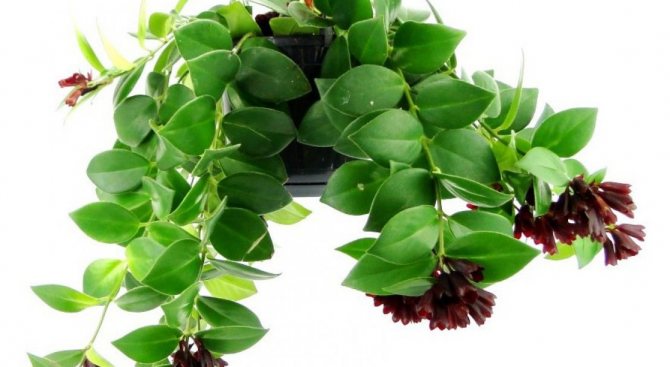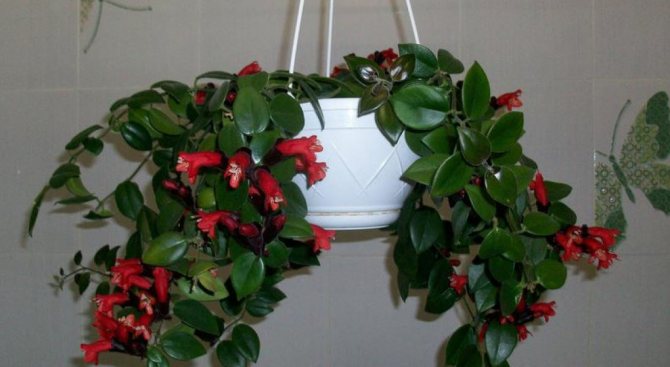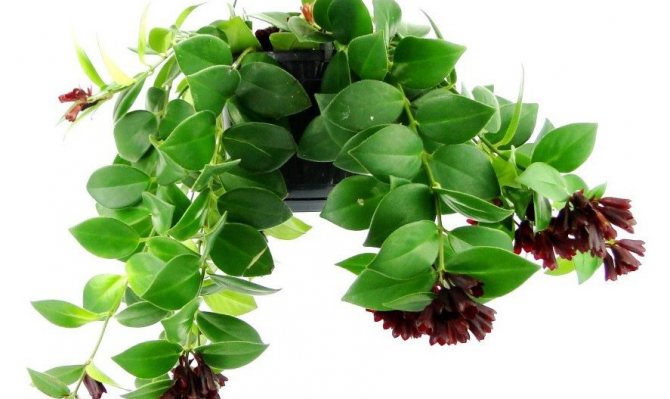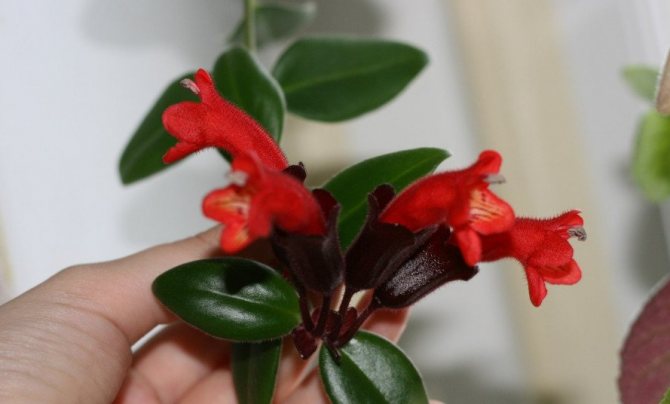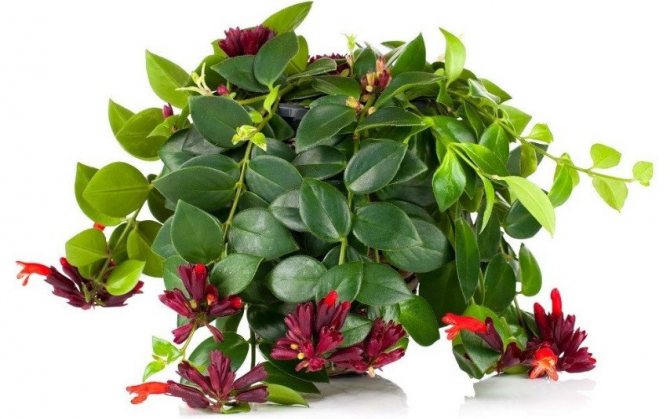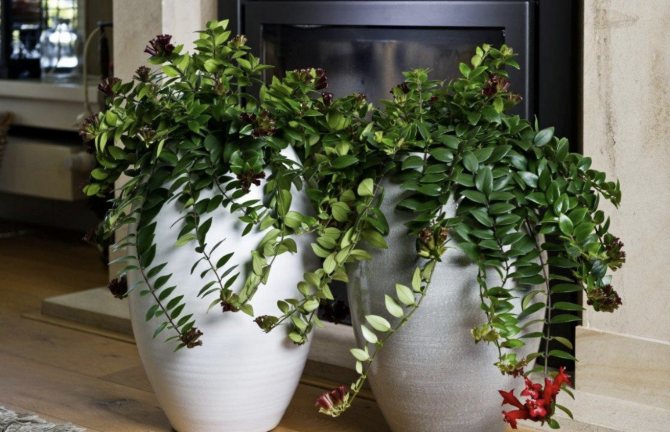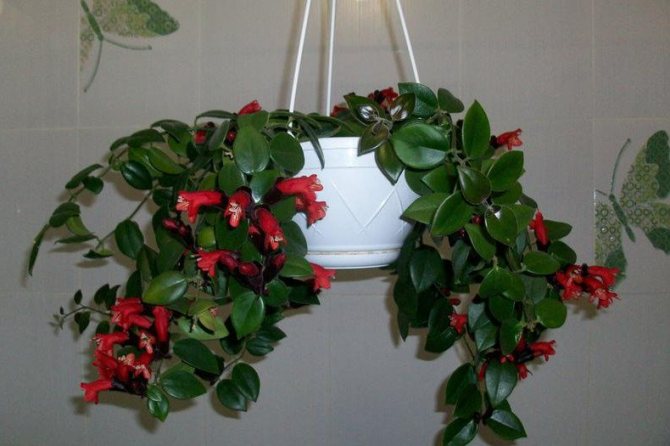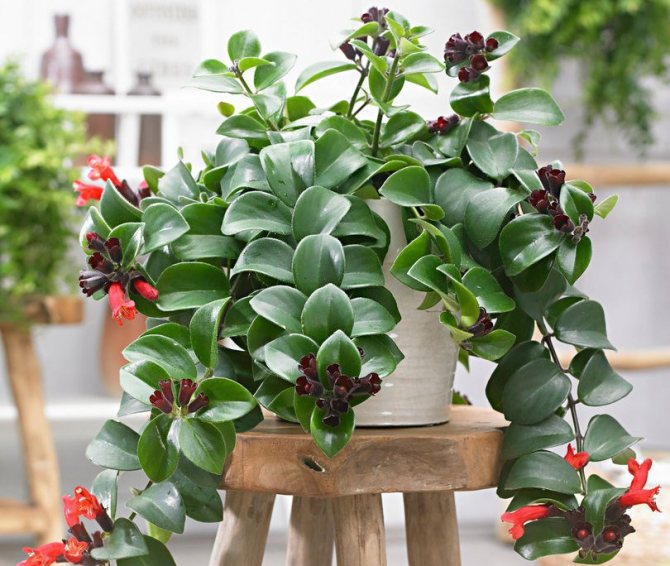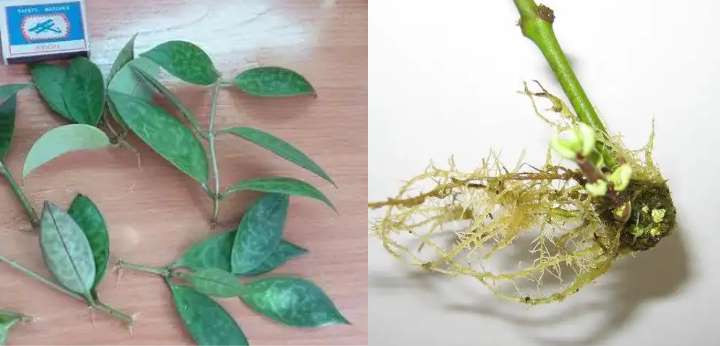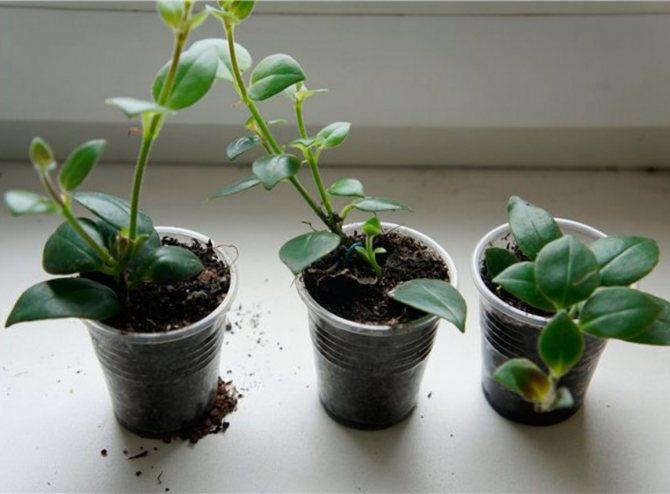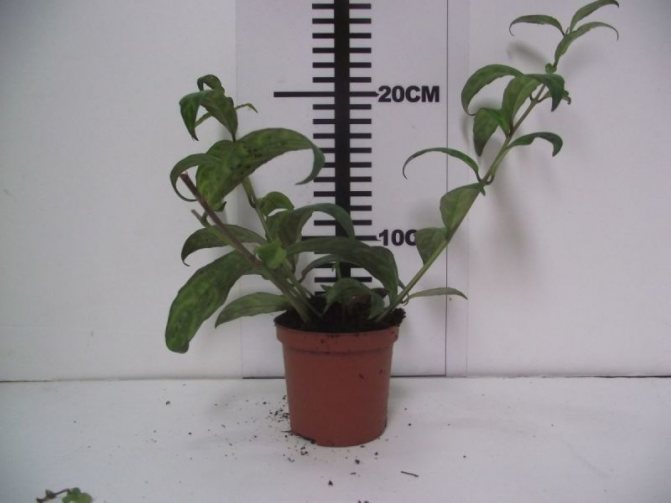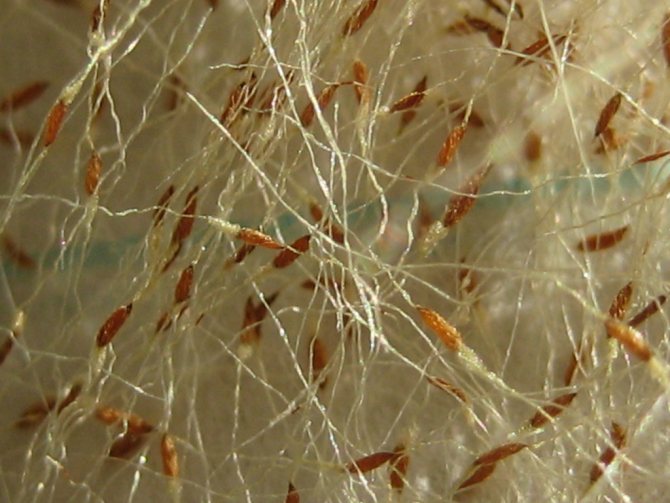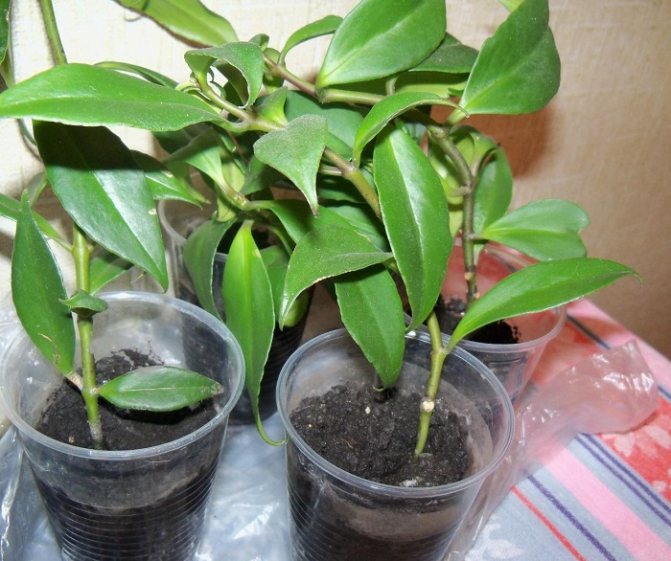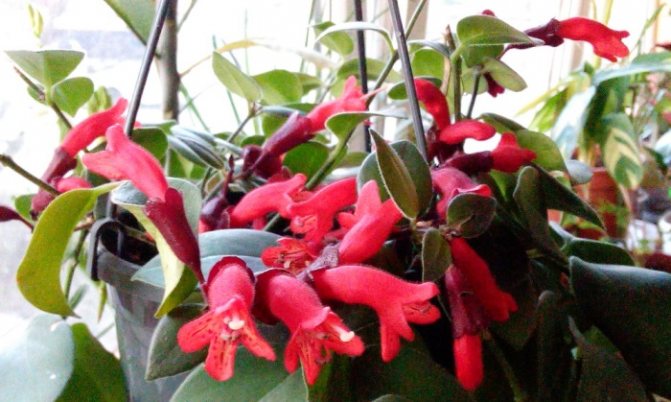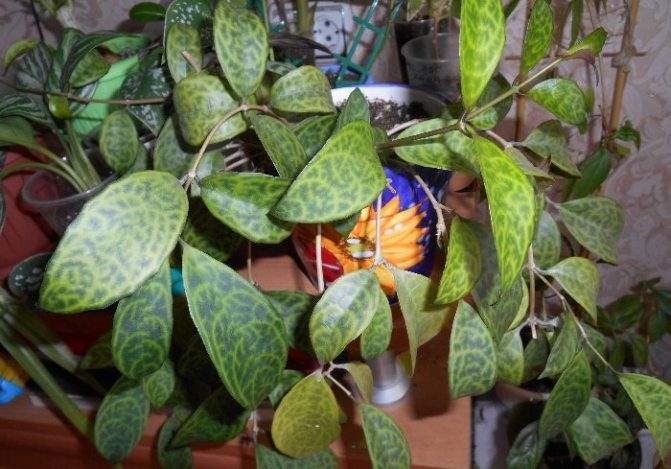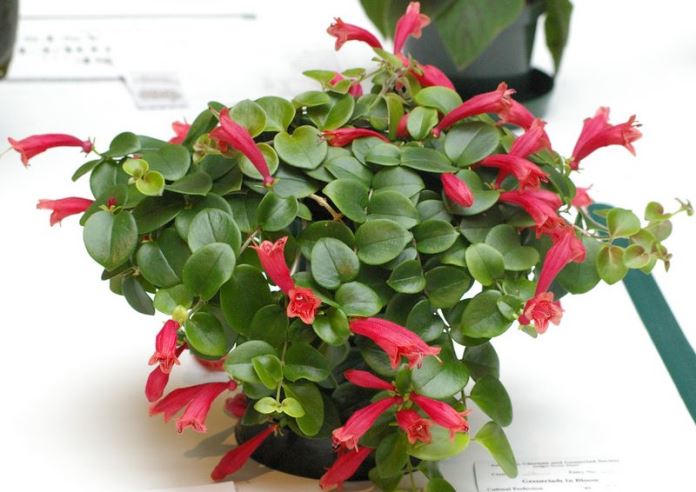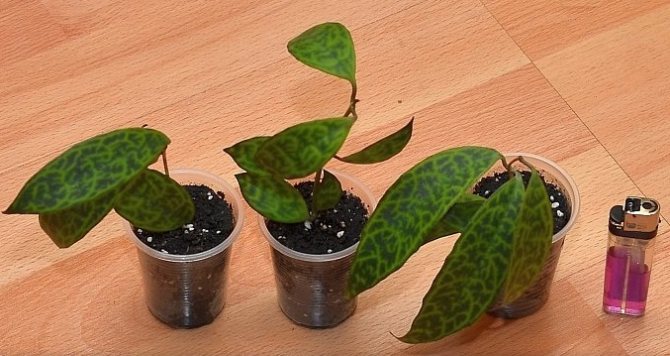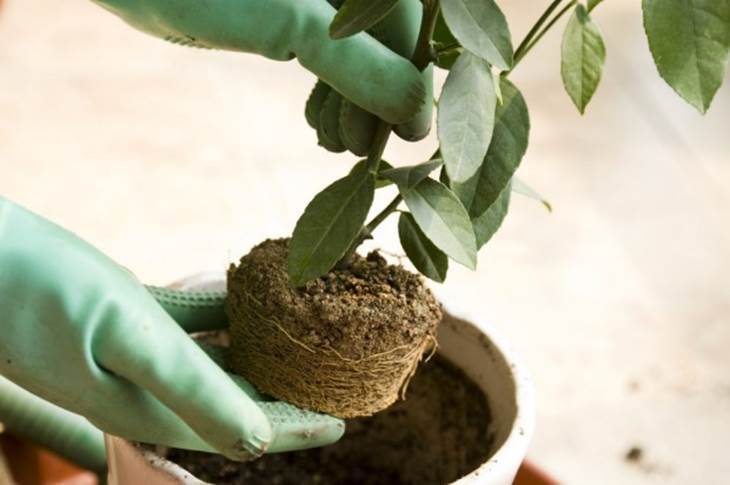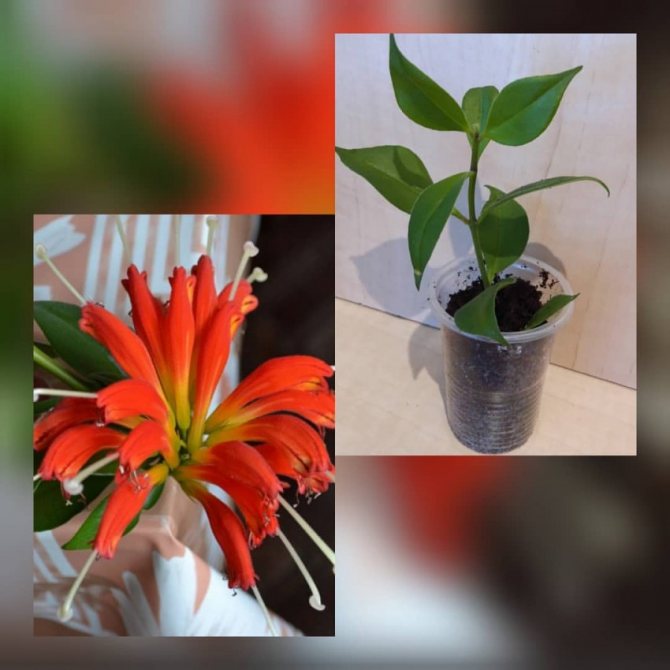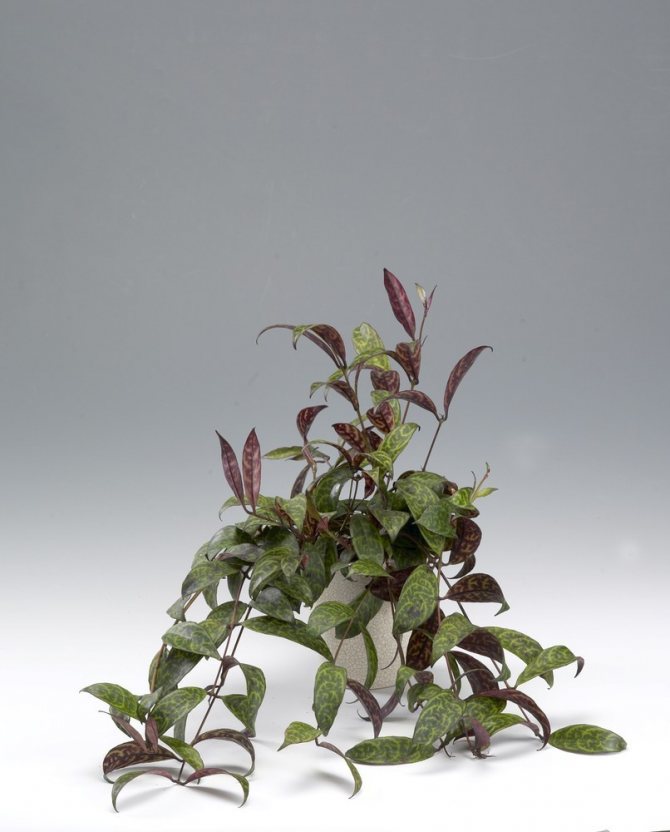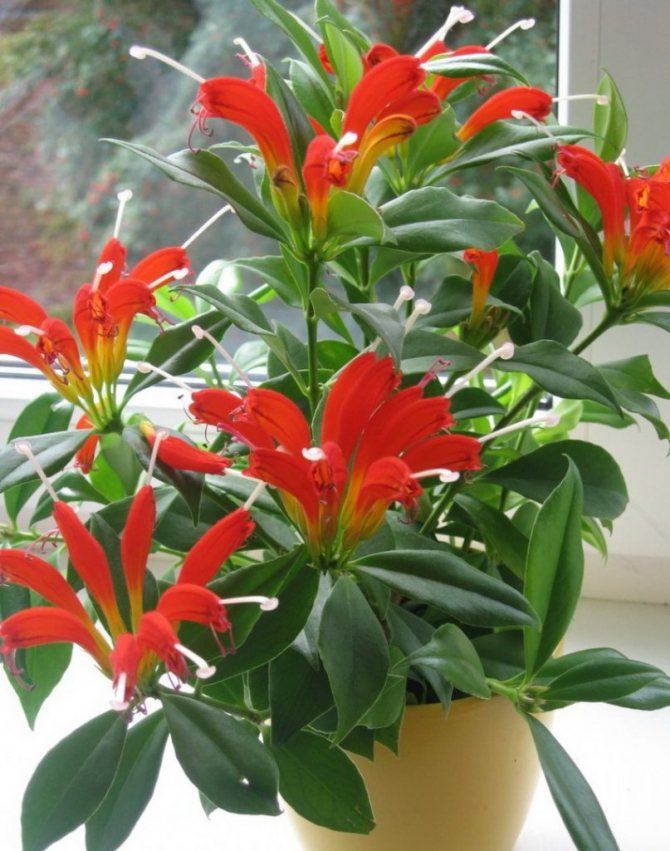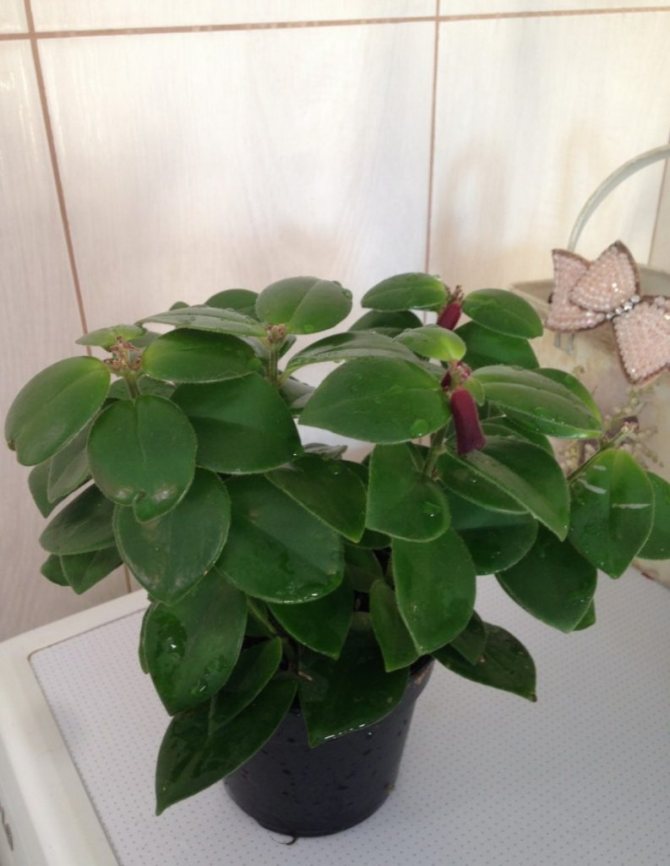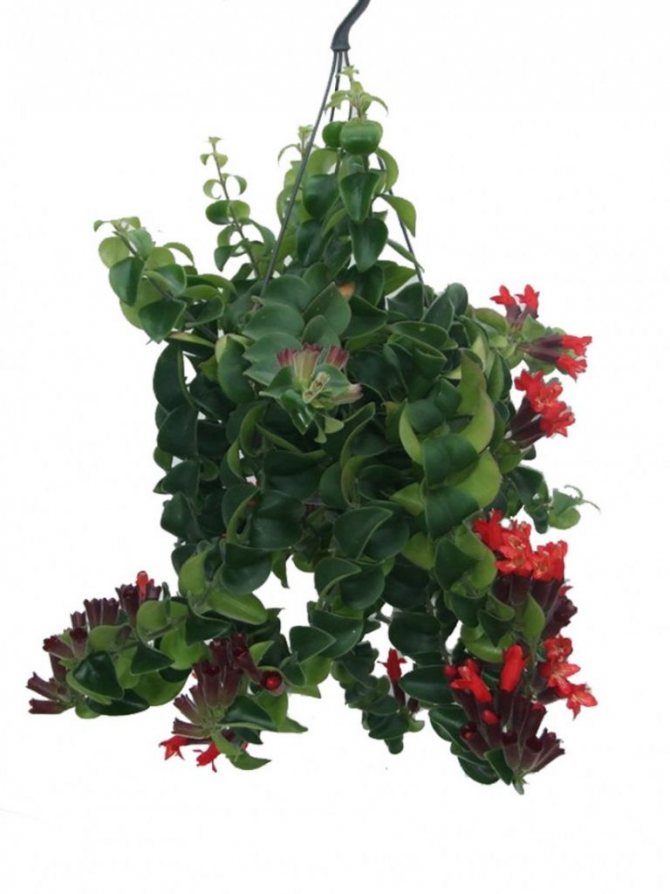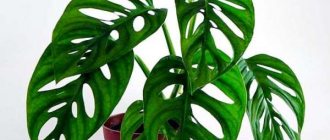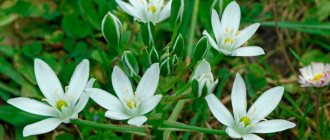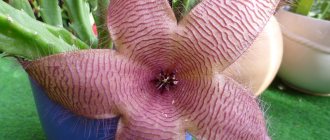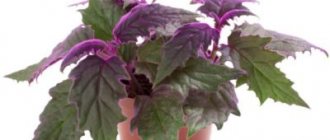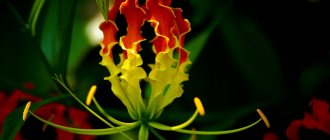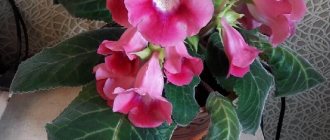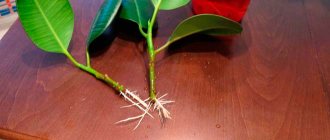Eschinantus belongs to the Gesneriev family. The name from ancient Greek sounds like a "distorted flower". Many have heard the popular name - "lipstick flower". Such names reflect the unusual, inverted shape and bright color of the flower. In this article, we will consider the basic requirements for caring for aeschinanthus at home, and also describe the main methods for propagating this flower.
Botanical description
Under natural conditions, the escinanthus flower is found in Thailand, Vietnam. A favorite habitat is the crown of trees, while the flower gets its nutrition from the soil. Can live on rocks, stones.
The length of the shoots varies from 30 cm to 1.5 meters. Leaves of rich green color are arranged in pairs. Their shape is oval, but with an elongated pointed end. Thick leaves are used to storing water, since moisture in tropical forests is available only during the rainy season.
Flowers are elongated tubes turned upside down. The surface of the inflorescences is covered with thin white villi. The color can be from yellow-orange to dark scarlet. Pollination in nature occurs with the help of sunbirds. With proper care, it blooms from June to October.
Reproduction methods
The plant needs to be renewed periodically. You can propagate it yourself in several ways.
Cuttings
The most affordable and common way. To obtain cuttings, you need to cut off the apical stems about 10 cm long, with 5-6 internodes on each. It is better to cut off the shoots before setting the buds or after flowering. Remove all lower leaves from cuttings, treat with a root formation stimulator. Place them to root in water or in a ready-made mixture of peat and sand (1: 1). Cover the cuttings with plastic or glass. Bottom heating is recommended for fast rooting. Roots are formed in 2-3 weeks on average. Then transplant the cuttings into separate pots with a suitable substrate.
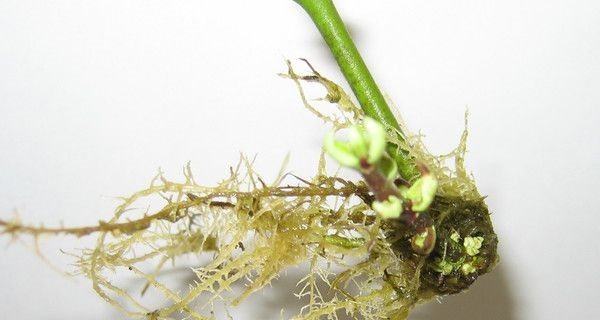
Sheet
For propagation by leaf cuttings, cut off the leaf plate with the bud. Treat the cut with fungicide or charcoal. Dry for 2-3 days. Plant in a container with wet sand, cover with foil. When leafy cuttings take root, they are transplanted into individual pots, several pieces are possible. After planting, cover the soil surface with a thin layer of sand.
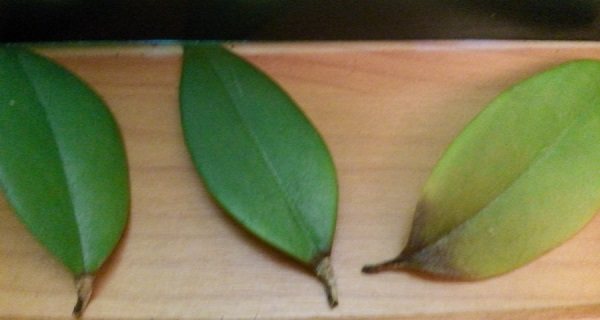

Growing from seeds
This method is rarely used due to its laboriousness. Crops often do not give a positive result. Seeds often do not germinate at all or young seedlings die quickly.
The seeds ripen in the seed capsule. They are very small. They are sown evenly over the soil surface, covered with foil. It is necessary to moisten the soil by the method of bottom irrigation through the pallet. Young seedlings are transplanted into small pots. After a year, the plant can bloom.
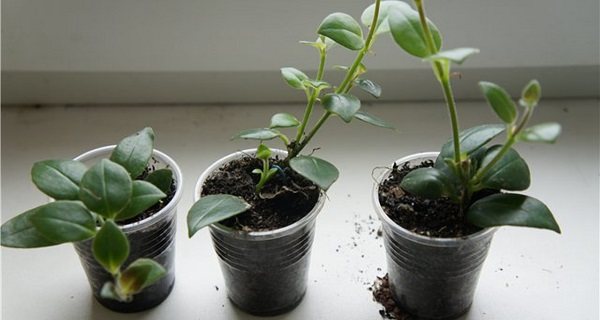

Types of lovely flower
The variety of species of Aeschinanthus is surprising. According to the data of the encyclopedic Internet project on plants, 194 species are described for 2013, and more than 200 for 2019. Of these, only about 15 species are grown at home. Cultivated species differ from each other in external characteristics and care features. The most famous varieties of aeschinanthus include:
- beautiful (Aeschynanthus pulcher);
- marble (Aeschynanthus longicaulis);
- magnificent (Aeschynanthus speciosus);
- twister (Aeschynanthus Twister);
- rocky (Aeschynanthus rupestries).
Beautiful
Florists prefer the beautiful Aeschinanthus because of its expressive appearance. The inflorescence is an umbrella of 9-12 flowers up to 6 cm in length, bright red at the ends and yellow in the middle. Stems reach 50 cm. The “beautiful” species is often confused with “beautiful” (magnificent).
Aeschinanthus is beautiful in the photo:
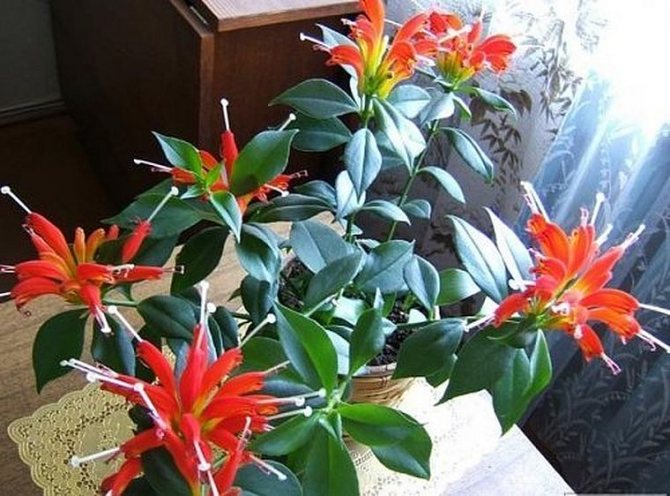

Great
The length of the stems is from 30 to 60 cm. The leaves are dense, up to 12 cm in length. Inflorescences of 10-12 orange flowers. Each flower is decorated with a red border along the top.
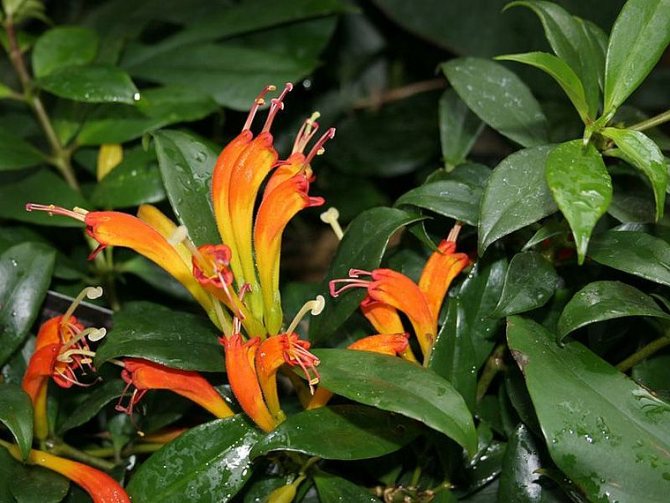

Marble
The peculiarity of the marble eschinanthus lies in the variegated color of the leaves. On the green plates, from the central vein, yellow patterned stripes extend to the sides, forming an ornament resembling marble. The inner side of the leaves has brown blotches. Inflorescences do not attract attention due to their green color. The length of the stems reaches 90 cm, hence the second name - "long stem".
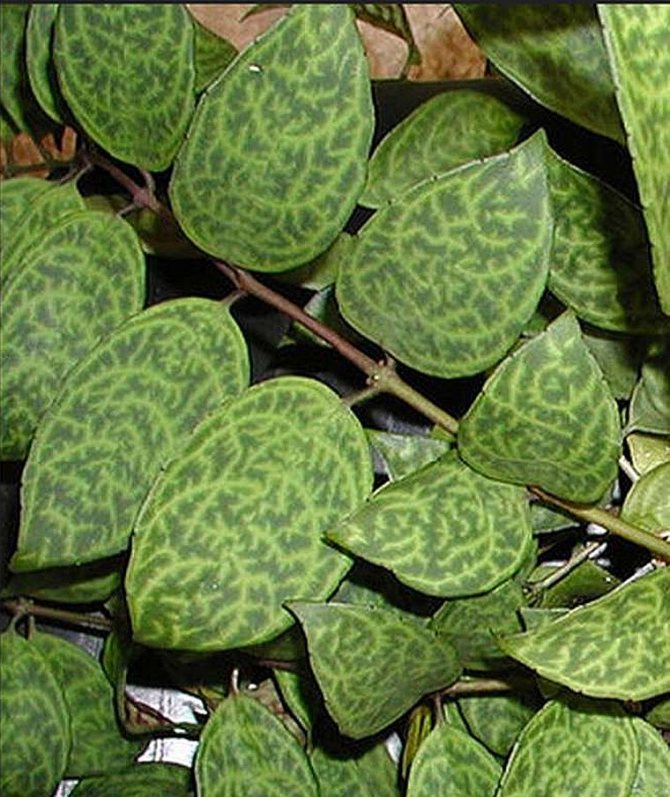

Twister (curly)
The leaves of the twister or eschinanthus are curly dark green in color, strongly curled inward, which creates the feeling of curls. The flowers are orange or red.
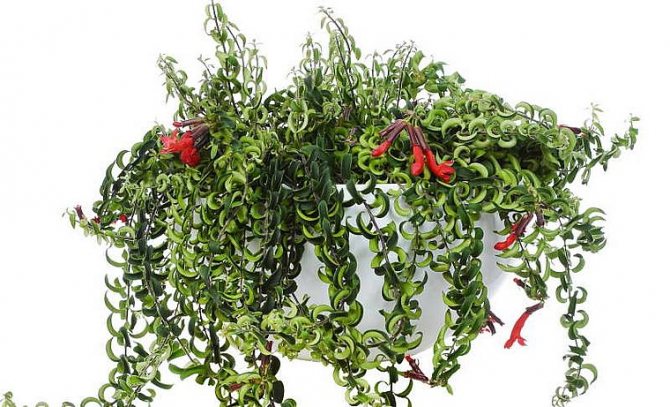

Rocky
The rarest species of Aeschinanthus. The shape of the leaves resembles oak, the flowers are of a delicate lilac hue.
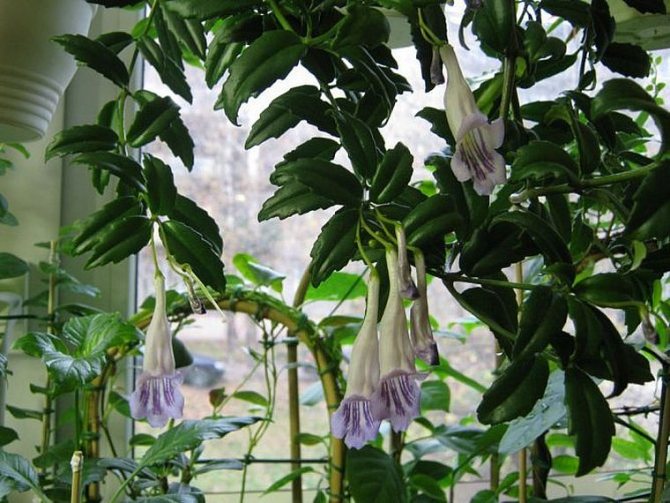

Types and varieties for growing at home
About 80 plant species are known, which are shrubs and semi-shrubs. For growing indoors, only some types of escinanthus are used.
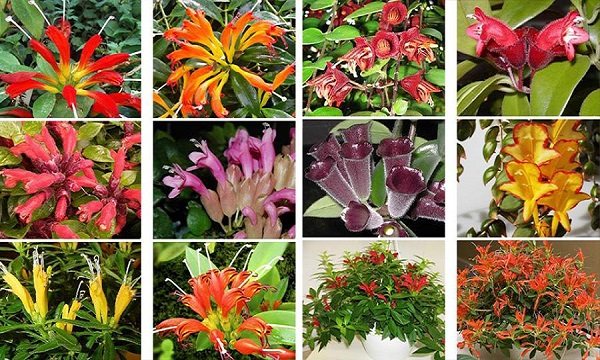

Beautiful
The most famous and popular. The plant is about 0.5 m high. Shoots are directed downward. As they grow older, they begin to grow stiff. Leaves are oval, elongated, olive shade. At the end of the shoots, inflorescences are formed that resemble a yellow-hot tube.
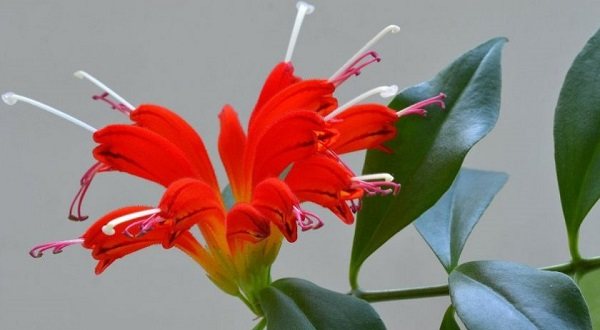

Marble
View with attractive variegated foliage. Its surface is decorated with light streaks. The seamy side of the leaves is chestnut. Flowers do not look very impressive and have no decorative value.
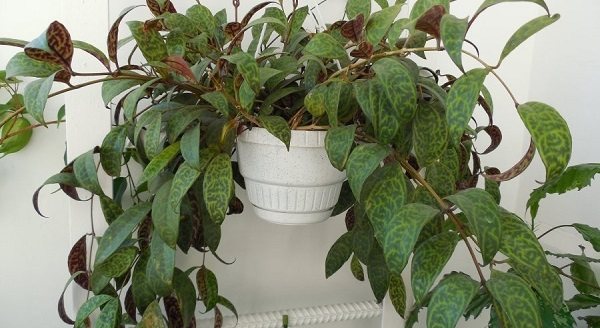

Lobba
A plant with flexible, pale red stems. Small oval dark green leaf plates are placed on them. From the inside, they are paler. Red flowers with a yellow tube form at the tops of the stems.
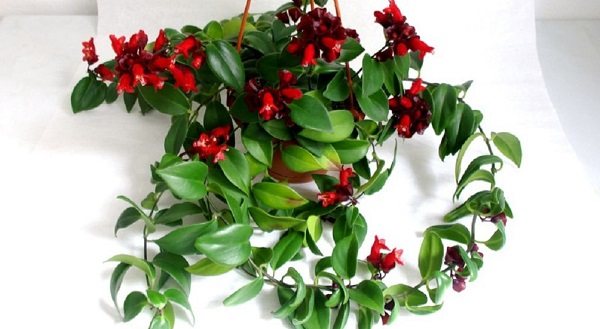

Mona lisa
One of the less demanding plant species. It is an ampelous plant with fleshy leaves. The flowers are curved, red.
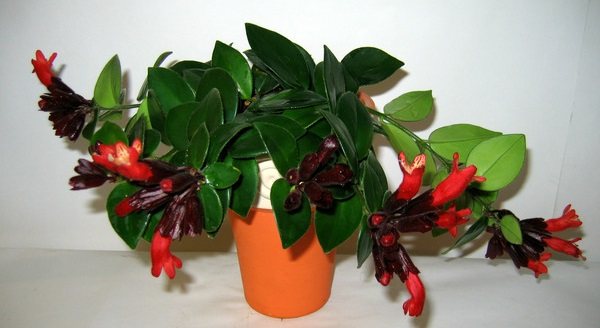

Twister
Aeschinanthus with twisting leaves and shoots. Outwardly, they resemble curls. The leaves are dark green, glossy. The flowers are reddish-orange and form at the tops of the branches.


Caroline
A compact shrub with curly stems. The leaves are elongated, about 8 cm. The flowers are red with a pale pharynx.
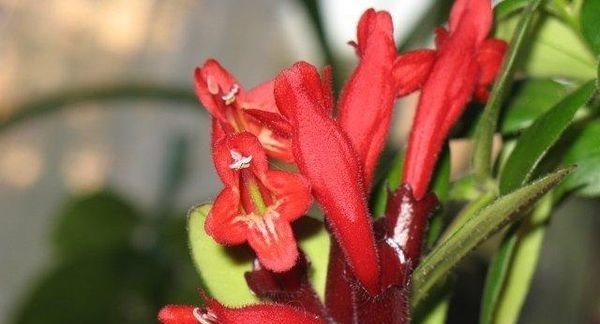

Varieties - additional beauty
The most popular varieties:
- Rasta (Aeschynanthus Rasta);
- Mona Lisa (Aeschynanthus Mona Lisa);
- Carolina (Aeschynanthus Caroline);
- Firebird (Aeschynanthus Firebird);
- Lobby (Aeschynanthus Lobbianus).
All these names are presented below in the photo.
Rasta
Leaves are elongated, dark green, curling inward. Red flowers on long hanging shoots look spectacular. The flowering period lasts from May to September.


Mona lisa
Eschinantus Mona Lisa is distinguished by unpretentious care at home compared to other representatives of the Gesneriaceae. Therefore, at home, it is found more often than other varieties. The flowers are orange-burgundy, the leaves are glossy olive. The shoots hanging from the pot form a dense cascade of greenery.
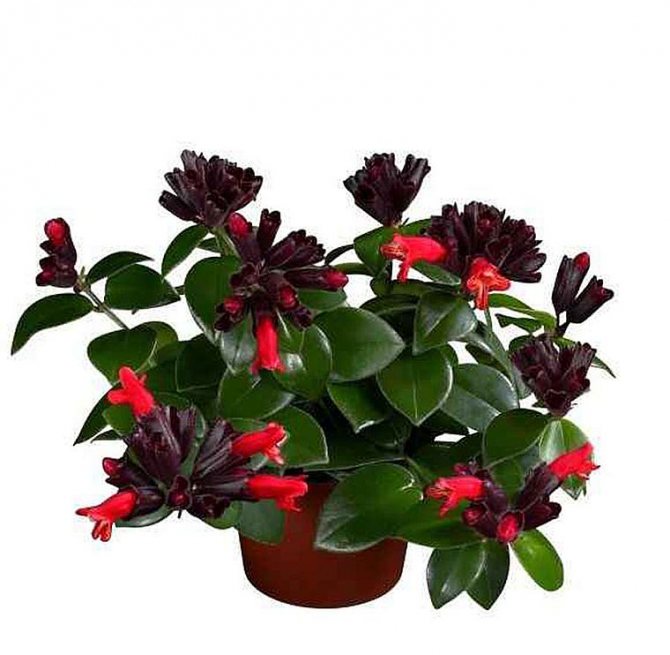

Caroline
The leaves of Carolina grow up to 9 cm in length and up to 6 in width, have the shape of an oblong ellipse. Inflorescences of a burgundy shade with a fleecy frame.
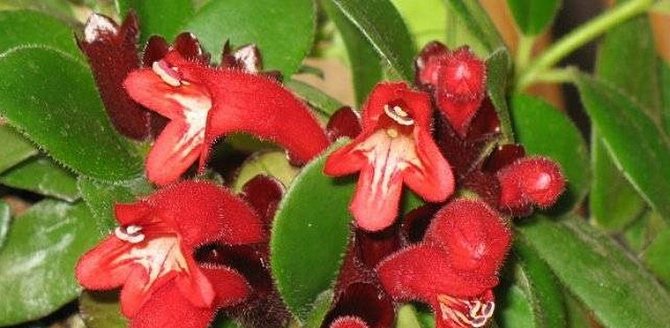

Firebird
It got its name from the orange-red inflorescences. The latest varieties of the Firebird are purple, pink and even multi-colored.
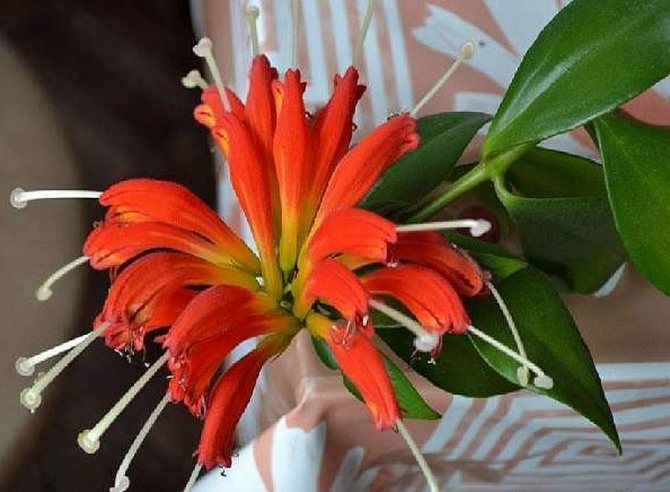

Lobba
Lobba's stems are long (50 cm), the leaves are small up to 4 cm and close to each other. Red flowers emerge from burgundy cups. Until the Mona Lisa variety was known, Aeschinanthus Lobba was considered the most popular.
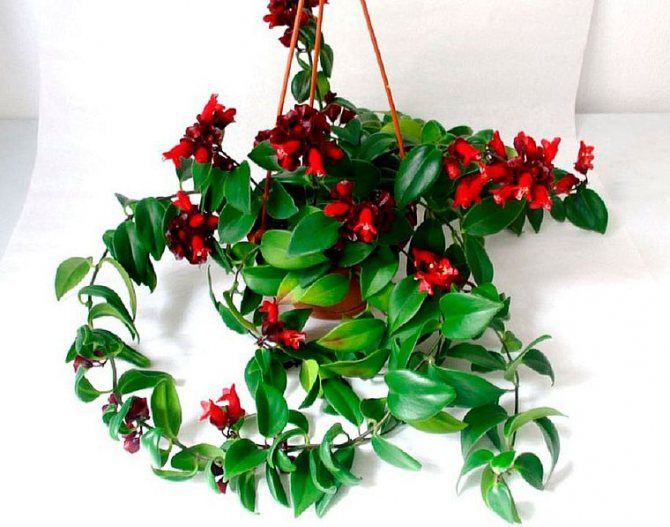

Care errors and their elimination
The following table summarizes common mistakes when growing Aeschinanthus and how to fix them:
| Problem | The reasons | Decision |
| Shedding foliage | Excess moisture at low air temperatures, or drying out of the soil, drafts | Water sparingly, do not overmoisten and do not overdry the earthy clod |
| Shrinking and falling leaves | Hypothermia, watering with cold or hard water | Place the flowerpot in a warm place, water with warm, settled water |
| Drying out the tips of the leaves | Elevated temperature and dry air | Spray the plant regularly, if it is hot in the room, in winter, remove it away from heating appliances |
| Slower growth, blanching leaves | Lack of feeding | Transplant the bush into a new, nutritious soil, fertilize regularly during the growing season |
| Light brown spots | Cold water for irrigation | Water should be + 20-25 degrees |
Proper home care
The indoor flower eschinanthus is very picky about the conditions of detention, since the grower will have to provide the conditions of the tropical forest. It is quite difficult to meet as a home plant in Russia, even greenhouses cannot always present this sample. Any wrong action can lead to the death of the flower. The key points in caring for aeschinanthus at home are presented below.
Where to put the flower
The ideal place for an eschinanthus can be a bathroom, if there is a possibility of natural light. Direct sunlight will have a detrimental effect on the plant, so it is better to place the pot away from windows. An acceptable option would be the western or eastern wall, because the flower looks more spectacular when suspended.
It is better not to place it in the children's room, since the juice of the leaves can cause allergic reactions on the skin.
Temperature, humidity, lighting
Sudden changes in temperature and drafts will cause the plant to shed its leaves along with the flowers. In summer and spring, it is worth maintaining the temperature of 23-26 °, in winter 18-20 ° is enough.
Maintain air humidity high, in the region of 60-70%. You can achieve the desired level with a humidifier, or by placing a container of water next to the pot. Lighting should be diffused.
Watering
Due to its thick leaves that retain moisture, the escinanthus can withstand a short drought. Excess watering will lead to root rot and death of the plant. It will be better to wait for the top layer to dry by 2-3 cm. The flower reacts sharply to hard water.
In summer and spring, water should be watered with settled water at room temperature no more than 2-3 times a week. Spraying should be carried out in such a way that water does not get on the inflorescences. In winter, water no more than 1 time per week.
Fertilizers
You can feed it during the period of active growth (spring and summer). Fertilizer to choose for flowering plants. Prepare the solution according to the instructions and dilute it with water 50%, then water the topsoil to protect the roots from burns. One feeding for 3 weeks will be enough.
Features of winter care
In winter, a lack of sunlight can result in yellow foliage. It is recommended to periodically expose the flower to an ultraviolet lamp. During the rest period, watering and movement in space should be limited.
Caring for aeschinanthus in the winter at home is key to blooming. At a temperature of 15-18 °, the laying of future flowers is faster. The buds can be seen at the end of February.
Pruning
Some species of Aeschinanthus cease to bloom without pruning.
If the shoot has released a bud, and after flowering, a haircut was not carried out, then the next year it may not have inflorescences.
A pruned plant will release new shoots and become even more luxuriant.
Transfer
Aeschinanthus is transplanted once every 3-4 years after flowering.Only the topsoil needs to be renewed annually. The new pot should be shallow, but at the same time wider than the previous one by 1-1.5 cm. The root system is transferred along with the old soil, because there is a high probability of damaging the roots. In a new pot, you just need to fill up the prepared soil and add a drainage layer from below. The soil mixture can be purchased ready-made, or you can make it yourself. To do this, mix:
- river sand (for water permeability) 1/4;
- peat 1/4;
- sheet land 2/4.
You can add peat moss.
Reproduction
There are 2 most common ways of breeding aeschinanthus:
- By shoots... Part of the shoot with several internodes is sprinkled with soil or simply placed in water until the primary root system is formed. Then a plant is planted in the prepared soil and covered with a film, creating a greenhouse. The temperature under the film should be around 25 °. After 3 weeks, the first shoots will be ready for transplantation.
- Seeds... It is necessary to wait for the flower to ripen, shake out the seeds and conduct a selection. The strongest "individuals" are placed under glass in the ground. Below you need to install a drip tray. After the seedlings are planted in separate pots.
Lighting
It is necessary to put the container with it away from sunlight. Although this plant is from the tropics, eschinanthus does not tolerate direct exposure to ultraviolet radiation, receiving burns on the leaves, which subsequently fall off.
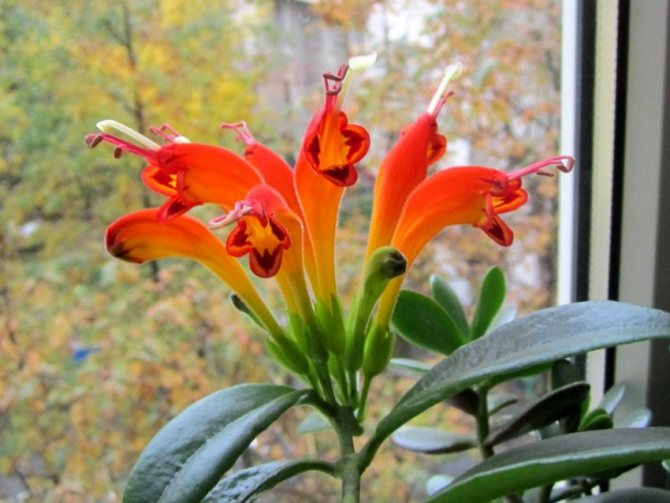

Western or eastern windows in the house, shaded with curtains, a bathroom or kitchen with good natural diffused light is the best solution. At rest (in autumn and winter), the shrub requires at least 14 hours of daylight hours.


Diseases and pests
With improper care, diseases and pests can cause significant damage to the plant. The most common are:
- aphid;
- gray rot;
- shield;
- powdery mildew.
The plant must be carefully examined. At the first symptoms of gray rot, it is recommended to spray with Fundazol. Soapy water will help with powdery mildew. Laundry soap will easily cope with aphids. Garlic infusion (0.5 water and a few crushed garlic cloves, mix, insist for a day) is used in the fight against the scabbard.
Features of seasonal care
Plant care rules depending on the season:
| Season | Lighting | Humidity | Temperature |
| Spring | Bright, some varieties require partial shade | Not less than 60-70%, you can increase it by spraying the leaves, or place a container with wet sphagnum next to the flowerpot | + 18-20 degrees, avoid drafts during ventilation |
| Summer | Bright, diffused | + 20-25 degrees, it is allowed to transfer the plant to the balcony, it is not advisable to place it on the street | |
| Fall | |||
| Winter | Bright, supplemented with special lamps | If the room temperature is low, there is no need to increase the humidity, especially in winter. | + 16-18 degrees, do not allow it to decrease less than +15 degrees |
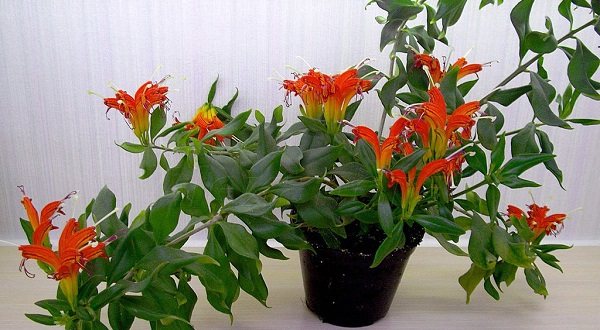

Flowering time
A young plant usually begins to bloom without any problems. But the next season, the flowering of Aeschinanthus marble may not come. Sometimes it is very difficult to figure out why the plant is capricious and does not gain buds. Consider the main reasons for the lack of flowering:
- Lack of illumination and vice versa, bright and long-lasting light.
- Insufficiently nutritious soil. The plant must be fed with potassium-phosphorus fertilizer.
- The pot is too large. In this case, the plant first grows roots, leaves, and only then flowers.
- Aging of the stems has occurred. The buds usually appear at the ends of the shoots once. After each flowering, a haircut is needed to refresh the flower.
- High winter temperature of escinanthus keeping. The lowered temperature promotes the setting of buds.
- Reduced humidity in the summer. When kept in hot and dry air, the buds are shedding, therefore, should be sprayed more often.
- Flower stress due to change of place.It is undesirable to rearrange the plant if buds have appeared.
Some growers claim that you need to communicate with the escinanthus, and then he will give buds.
How to properly care for a flower at home
It is advisable to transplant the flower immediately after purchase using the transshipment method, leaving the soil at the roots. The soil mixture should include the following components:
- sphagnum;
- coir;
- peat;
- sheet soil;
- charcoal.
Better to do this in the spring. After transplanting, you need to hold the plant in a slightly darkened place, and water it abundantly, but not leading to rotting of the roots.
Lighting should be good, bright, but always diffused. In summer, the temperature range should fluctuate between 20-25 degrees. And in winter, from about the end of February, it is necessary, leaving the lighting at the same level, to keep it for about a month and a half in the temperature range of 13-14 degrees.
High humidity is also needed. We do not have it, so you need to increase the humidity yourself. To do this, it is enough just to periodically spray the plant with a spray bottle. Watering should be abundant 1-2 times a week, always with settled water. There shouldn't be too much of it. The excess from the pallet should be removed immediately.
Plant transplant
It is customary to replant young plants of Aeschinanthus marble annually in the spring, when they begin to awaken. Adult specimens prefer cramped pots and do not like changing them. They are transplanted only when the roots have completely filled the entire pot and stick out of the drainage hole, and the plant itself has stopped developing. With the healthy state of the indoor flower, the transplant is done by transshipment, so as not to harm the roots. It is better to transplant the newly purchased eschinanthus immediately in order to replace the soil heavily saturated with fertilizers and slightly increase the pot in volume. Remember that a large pot will slow down flowering. The plant looks good in wall-mounted planters and hanging baskets when the stems hang down freely. Sometimes the flower is placed on supports or high stands.
Leaf rooting
For reproduction of marble eschinanthus in the absence of suitable shoots, you can use a leaf with a bud.
For this you need:
- Cut off a leaf with a bud from the plant with a sharp knife.
- Dip the cut in fungicide and sprinkle with charcoal powder.
- Let the slice dry in the open air for 2-3 hours.
- Plant in a container with river sand, after watering it.
- Cover with a bag or jar.
A new plant will appear in about a month and a half.
Video
This video will help you figure out how best to care for Eschinanthus at home:
The reader may be interested in articles about other rare plants:
- Setcreasia Violet (purple);
- Scindapsus (Potos);
- Tolmia;
- Tunbergia;
- Philodendron;
- Ceropegia Sanderson;
- Cyanotis;
- Cissus;
- Epipremnum.
Substrate
The soil should be loose to allow air and moisture to pass through, as well as rich in nutrients. The substrate can be purchased at the store or prepared by yourself. In the first case, it is recommended to choose a soil mixture containing fine expanded clay or other components that ensure the looseness of the soil. In the second case, you will need:
- river sand;
- peat;
- leafy soil;
- sphagnum.
The components should be in a 1: 2: 2: 1 ratio. You can add some charcoal or chopped bark to the substrate.
It is better to use a low wide pot for planting.
Growing aeschinanthus from seeds
To get a full-fledged plant from very small seeds wrapped in fluff will take a long period, patience, a universal soil for seedlings, a warm, well-lit place.
The method is more often used for breeding purposes. Sowing is carried out at the end of February under a shelter and, until the emergence of shoots, maintain humidity, ventilate, remove condensate.Seedlings are gradually adapted to natural conditions, increasing the time without shelter. The grown seedlings are seated in a permanent place.
Air humidity
Originally from hot countries, Aeschinanthus has such foliage that is able to accumulate moisture. Thanks to this, the plant does not need high air humidity (lowered indicators are also not afraid of it). In hot weather, it is recommended to spray the leaves of the plant 1-2 times a day, while trying not to wet the flowers. The culture should be moistened with warm, settled water.
In winter, it is not necessary to spray the bush, but if the humidity level has dropped significantly, then it is recommended to put the container with escinanthus on a pallet with wet expanded clay.
The room where the culture is located should be regularly ventilated, while trying to avoid drafts.
Pruning and shaping aeschinanthus
On this crop, pruning can be done as needed. If the plant is stretched out, shedding leaves, and producing too long shoots, then the branches can be shortened to give them a more compact shape and awakening. But still, the most spectacular appearance from Aeschinanthus can be achieved with regular formation.
In this case, annual pruning can be carried out both before and after transplantation, but only at the moment of the start of growth.
The main measures for the formation of aeschinantus:
- Pruning of all shoots, in which the "bottoms" begin to bare, to stumps of 10-20 cm.
- Pinching or cutting off 2 or 3 upper pairs of leaves on all young leafy shoots growing from the base.
Marble
The uniqueness of the marble eschinanthus lies in the beauty of the large leathery leaves. Their upper side has a dark green shade with spots of yellow, the reverse is painted in a brown-purple shade with a specific marble pattern. Against the background of chic leaves, the flowers look very modest. Even after opening, they are colored green with a yellowish upper part on the petals. The plant has long stems with well-developed lateral shoots. Subject to the rules of care - providing a sufficient amount of light, heat, water and special mineral additives, the flower grows quickly and decorates the interior of the room.
Useful pruning
Rejuvenating and sanitary pruning is a must for home care plants. At the end of the winter period and being at rest, dried, very elongated and bare stems, as well as damaged leaves, are removed from Aeschinanthus marble at the end of the winter period. After each flowering, the shoots are shortened in order to stimulate the laying of buds for the future period. In addition, it is necessary to pinch the tops to allow lateral shoots to grow. From this, the flower will look more lush and more buds will appear on young shoots.
Top dressing and fertilizer composition
Top dressing for aeschinanthus begins to be carried out as soon as the plant starts to grow and ends with a stop to growth. For aeschinanthus, the standard frequency of 1 every 2 weeks is excellent.
One of the interesting features of Aeschinanthus is that they do not like organic fertilizers, including all types of biofertilizers and modern preparations based on vermicompost. For them, it is better to use only mineral supplements. It is easy to choose the type of fertilizer: aeschinanthus grow better when fed with universal full mineral fertilizers, because both greenery and flowering are equally important for them.
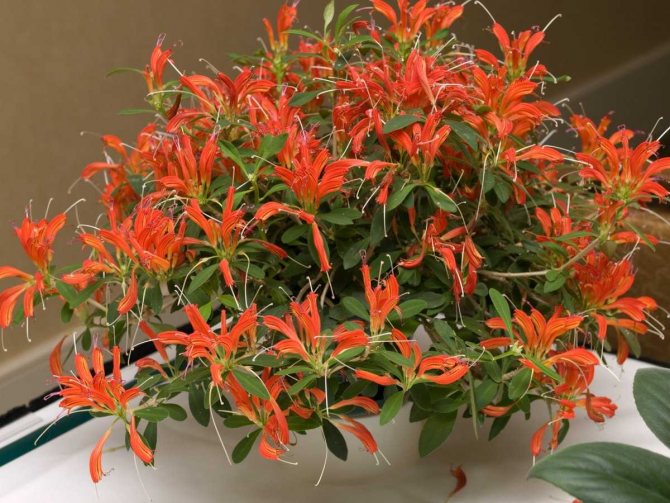

Aeschynanthus squat (Aeschynanthus humilis).

